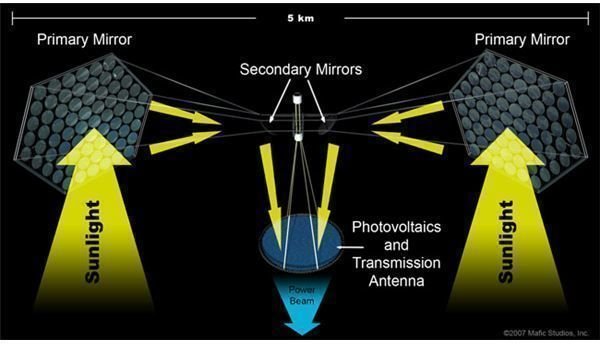The Solar Power Satellite (Space-Based Solar Power)
Introduction
The generation of power in space could be a good solution for the ever increasing demand for energy by human kind. The sun is a clean and inexhaustible source and there are different types of technologies that use solar energy to produce other types of energy (electricity, heat, light etc).
Solar Power Satellites
Solar power satellites (SPS) have been studied by space agencies worldwide during the past four decades. The process of acquiring energy by using a space-based solar power consists basically of three parts:
1. Collecting the solar energy in the space. Most technologies of SPS focus on photovoltaic conversion, since it is more technically feasible than the dynamic solar thermal power system.
Photovoltaic systems constitutes a technology that converts the sunlight directly into electricity. It uses solar cells, which are electronic devices made of semiconductor materials that are able to absorb the solar energy and produce “free” electrons.
2. Transmitting the energy to the Earth. In this kind of system, the solar-generated power is converted to microwaves and transmitted to the Earth (wireless power transmission). Peter Glaser, a technologist in Massachusetts, was the first person to spread the idea of beaming energy to Earth via satellite. The power transmitted to the Earth has to be a non-ionizing radiation in order not to cause biological and ecological harm. The microwave beams are preferred over the laser beams because of their higher transmission efficiency.
3. Receiving the energy via a rectenna. Receivers on the surface of the planet convert the microwave beam back into DC power (by rectifying antenna) for electrical grids.
The collection of a high quantity of energy by the satellite requires a huge structure, much larger than the International Space Station. The size of the satellite would be mainly determined by the size of the collector panels and by the size of the antenna that transmits the microwave.
Advantages and Disadvantages
An Earth-based solar panel is useless when the spot is dark, what happens half of the time, in average. Also, the power production is less efficient in cloudy days. A solar power satellite in orbit can be positioned so that the panels placed on it can constantly receive the sunlight with the advantage of being above the atmosphere. Solar energy is around 8 times stronger in space than on the surface of the planet.
Though power transmission to stations on Earth implies losses, because of the absorption or reflection of the energy by the atmosphere, space solar power still has advantages over Earth-based panels, since the efficiency of converting a microwave beam to electricity is greater than the efficiency of getting electrical energy from the sunlight. Furthermore, the space-based system would not suffer from contamination or corrosion and there would be no dependence on weather conditions.
However, placing solar panels on the ground is much easier and less expensive than using satellite systems. A huge investment is needed to get a satellite into orbit. Besides, other problems could appear in the space environment, such as higher radiation damage. The SPS technology is still immature, which keeps it from being a cost-competitive power in the present, though some people see it as the best alternative to nuclear power plants.
References
David Boswell - Whatever Happened to Solar Power Satellites?
Leonard David - Space Power for An Energy-Hungry Earth
Seth Potter - Solar Power Satellites: An Idea Whose Time Has Come
NASA - Reinventing the Solar Power Satellite
National Space Society - Space Solar Power
